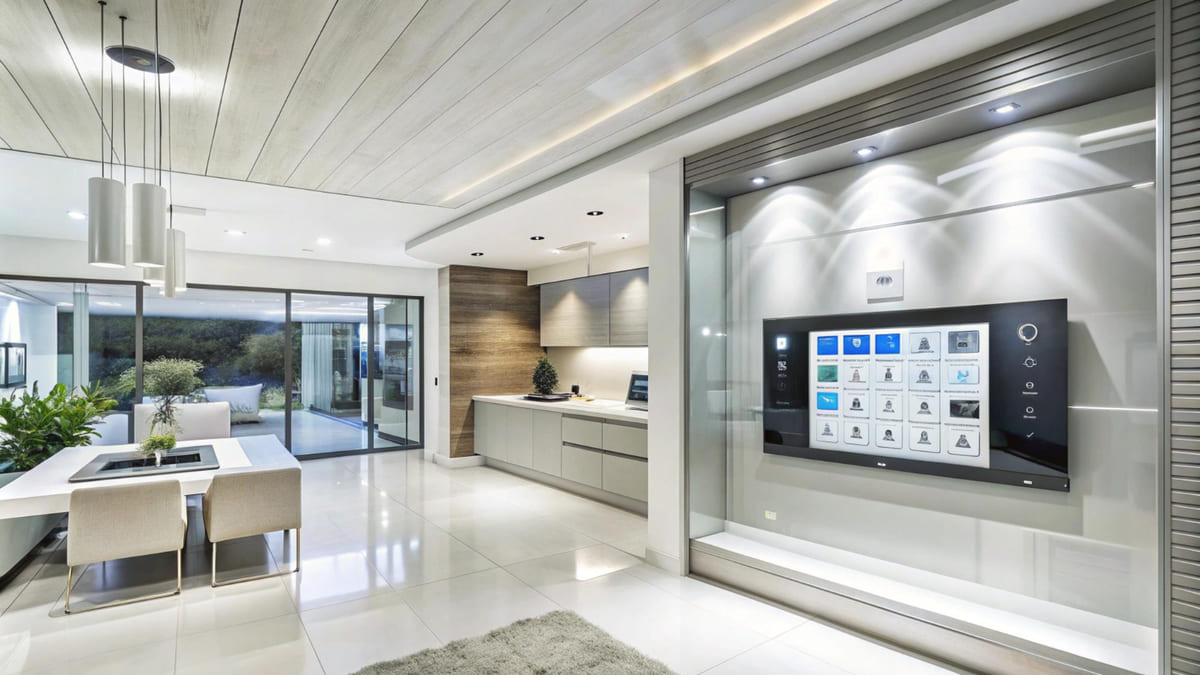IoT Building Automation Systems refer to the integration of Internet of Things (IoT) technology with traditional building control systems. These systems connect sensors, devices, and software to monitor and manage a building’s environment in real time. In practical terms, an IoT-enabled building can automatically adjust heating, ventilation, lighting, security, and other functions based on data. For example, if a room becomes occupied, IoT sensors can signal the system to turn on lights and adjust the temperature, improving comfort without manual intervention.
This guide provides a comprehensive overview of IoT building automation, covering how it works, its components, benefits, challenges, and applications across commercial, residential, mixed-use, and institutional buildings. We also focus on European standards and regulations influencing these systems. The tone is objective and technical, offering clear explanations and real-world examples suitable for training or documentation.
Table of Contents
Components and Architecture of IoT Building Automation Systems
IoT building automation systems are composed of several key components working together in a layered architecture. Understanding these components is crucial to grasp how the overall system functions:
1. Sensors and Devices
These are the “eyes and ears” of the building. Sensors collect data on various parameters like temperature, humidity, light level, motion, air quality (CO₂, VOCs), and occupancy. In turn, actuators or controlled devices carry out actions – for instance, adjusting a valve in the HVAC system, dimming lights, or opening window shades. Modern IoT sensors are often wireless and battery-powered (or energy-harvesting), making them easy to install even in existing buildings without extensive wiring.
2. IoT Gateways and Controllers
At the local level, IoT gateways or controllers act as intermediaries between field devices and higher-level systems. They aggregate data from sensors and execute control logic. In a traditional Building Management System (BMS), programmable controllers manage subsystems (like HVAC controllers). In IoT-based automation, these controllers are increasingly smart IoT gateways that can connect to the internet. They preprocess data (edge computing) and ensure critical controls still function if the cloud connection is lost. For example, a gateway in a building may continue to maintain climate control locally, even if cloud connectivity drops.
3. Network and Communication Infrastructure
Communication networks tie the system together. IoT Building Automation Systems use both wired and wireless networks:
-
Wired Networks: Ethernet and proprietary bus systems (e.g., BACnet/IP, KNX TP cable, Modbus) link devices reliably within buildings. Power over Ethernet (PoE) is often used to both power and connect devices like sensors and cameras through a single cable.
-
Wireless Networks: These have become essential for IoT flexibility. Wi-Fi, Bluetooth Low Energy, Zigbee, Z-Wave, and Thread are common wireless protocols connecting devices without cumbersome cabling. Low-power wide-area network technologies like LoRaWAN or NB-IoT might be used for connecting sensors across large facilities or campuses. A secure and robust network is fundamental so that all devices can communicate in real time.
4. Cloud Platform and Edge Servers
A distinguishing feature of IoT-based automation is the use of cloud computing. Data from the building is sent to cloud platforms or central servers where advanced analytics and machine learning algorithms can run. The cloud platform serves as the brain of the system – processing data, running optimization routines, and sending back commands. It also provides centralized dashboards and remote access. For instance, facility managers can log into a cloud dashboard to see live data or adjust settings for any building in their portfolio.
Many systems adopt a hybrid approach: critical controls are handled by on-site controllers for safety, while the cloud performs heavy data analysis and long-term optimizations. This architecture improves scalability – a cloud-based BMS can manage multiple buildings and vast data sets seamlessly.
5. Software and User Interfaces
At the top layer, software applications allow humans to interact with the automation system. Graphical user interface dashboards, mobile apps, and web portals display the building’s status and performance metrics. Through these interfaces, authorized personnel can override settings, schedule operations, or analyze trends. Modern interfaces are often unified, meaning one platform shows all integrated systems (HVAC, lighting, security, etc.) together. For example, a building operator might use a single dashboard to check temperatures on each floor, see which lights are on, and receive alerts if any device malfunctions. Additionally, software may integrate with building maintenance systems, sending notifications for preventive maintenance if a sensor detects an anomaly in equipment performance.
Overall, the architecture of an IoT Building Automation System is distributed and connected. Sensors at the edge gather data, controllers act on that data, networks connect all parts, and cloud or server-based intelligence optimizes the whole building. This connected architecture enables buildings to function more like living organisms – sensing, analyzing, and reacting continuously to both internal changes and external factors (like weather or energy prices). In the next sections, we’ll discuss how these systems communicate and adhere to standards, especially in the European context.
Suggested article to read: Building Automation System (BAS): Ultimate Guide for 2024

Communication Protocols and Standards in Building IoT
For IoT building automation to work reliably, all the devices and components must speak a common “language.” Communication protocols and standards ensure interoperability between sensors, controllers, and software from different manufacturers. In Europe and worldwide, several key protocols are used in building automation systems:
-
BACnet (Building Automation and Control Network): BACnet is an open protocol specifically designed for building systems. It allows HVAC, lighting, fire safety, and other building equipment to communicate on a unified network. BACnet/IP (the IP-based version) is popular in large commercial buildings. Many European buildings use BACnet as a standard for integrating multi-vendor systems, since it’s an ISO standard for building automation.
-
KNX: KNX is a widely adopted European standard (EN 50090, ISO/IEC 14543) for home and building automation. It is common in lighting and shutter control, HVAC, and security systems, especially in Europe. KNX devices can communicate over twisted-pair wiring, powerline, or radio frequency. With the rise of IoT, KNX IoT specifications now enable KNX devices to interface over IP networks, enhancing integration with other IP-based IoT devices. KNX’s longevity and guaranteed interoperability have made it a backbone of many building projects in EU countries.
-
Modbus and LonWorks: These are other established protocols. Modbus (an older serial protocol) is still used for some equipment communications. LonWorks/LonTalk was historically used in building controls as well. While their usage has declined in favor of IP-based standards, they can still be found in legacy systems, and IoT gateways often include translators for them to bring legacy devices into the IoT ecosystem.
-
Wireless IoT Protocols: In modern IoT BAS, wireless communications are key. Zigbee and Z-Wave are two wireless mesh network protocols commonly used for smart lighting, thermostats, and sensors (especially in homes or smaller commercial settings). Thread is an IPv6-based mesh protocol (adopted in the new Matter standard for smart homes) that is emerging for reliable, low-power device connectivity. Bluetooth LE is used for some occupancy and asset tracking beacons. These wireless standards are important for retrofitting buildings, as they avoid the need to install new cabling.
-
IP and MQTT/CoAP: The use of Internet Protocol (IP) throughout building networks is a growing trend. Many devices now have IP addresses and use common internet standards. MQTT (a lightweight publish/subscribe messaging protocol) is widely used in IoT systems to send data from devices to cloud services efficiently. For example, a temperature sensor might publish its readings via MQTT to a cloud broker that the building’s analytics platform subscribes to. CoAP is another lightweight protocol often used for constrained devices. Embracing IP and these IoT protocols means building devices can integrate more easily with IT systems and web services.
-
Interoperability Standards: To truly unlock IoT potential, data needs to be understood universally. Efforts like Project Haystack and Brick Schema provide standardized tagging and semantic models for building data. In Europe, initiatives under the Smart Readiness Indicator (SRI) encourage open data and interoperability so that buildings can easily connect with external services (like smart grid or demand-response programs). Additionally, the emerging Matter protocol (backed by major tech firms) is unifying smart home IoT devices – which could influence future residential building automation by ensuring devices from different brands work together out of the box.
In summary, IoT building automation leverages a mix of traditional building automation protocols and newer IoT communication standards. European projects often blend systems – for instance, using KNX or BACnet within the building and MQTT to link to cloud analytics. Adhering to recognized standards is crucial in Europe due to regulatory preferences for interoperability and open systems. Building owners benefit from this standards-based approach because it avoids vendor lock-in and makes future upgrades or expansions easier.
Applications and Use Cases Across Building Types
One strength of IoT Building Automation Systems is their versatility across different building categories. Regardless of building type – commercial office, private home, mixed-use complex, or institutional facility – the core idea is to use connected technology to run the building more intelligently. Here we explore how IoT automation applies in various environments:
1. Commercial and Office Buildings
In commercial office buildings and retail spaces, IoT automation focuses on energy efficiency and occupant comfort. For example, a modern office tower might deploy occupancy sensors and smart thermostats in every room. When a conference room is booked and people enter, the system can automatically turn on lights, adjust ventilation to maintain CO₂ at healthy levels, and cool the room to a comfortable setpoint. Conversely, when spaces are unoccupied, lighting and HVAC setpoints are reduced to save energy. IoT-based space utilization sensors can also feed data to facility managers about how often meeting areas or zones are used, helping optimize layouts or cleaning schedules.
In retail settings, IoT sensors manage lighting and climate to provide a pleasant shopping environment while minimizing utility costs during off-peak hours. Integration with security and access control is common too – for instance, badge access data can tell the building automation system which floors are occupied after hours, so only those areas get full lighting and cooling. Real-world example: in a large office in London, IoT sensors combined with weather data services pre-cool the building in the early morning on hot days, preventing employee discomfort and reducing peak electricity use.

2. Residential Buildings (Smart Homes and Apartments)
IoT automation is transforming residential buildings into smart homes. Individual houses or apartment complexes use IoT devices like smart thermostats, smart lighting, and voice-controlled assistants to enhance convenience and efficiency. For instance, a smart thermostat learns a family’s routine and adjusts heating accordingly – turning down the heat when the occupants leave for work and ensuring it’s cozy by the time they return. Lighting systems can be scheduled or controlled via smartphone and even respond to ambient light; blinds might close automatically at midday in summer to reduce cooling load. Security and safety are another major aspect: connected cameras, smart door locks, and leak detectors send instant alerts to homeowners, whether they are on-site or remote.
In multi-unit residential buildings, IoT automation can manage common areas’ HVAC and lighting, monitor elevators and equipment for maintenance needs, and allow residents to book facilities (like a gym or laundry room) through a smart app. The benefit in residential contexts is not just energy savings, but also improved quality of life and peace of mind for occupants through automation. Notably, aging buildings in Europe can be retrofitted with IoT devices (often wireless) to gain smart capabilities without major renovations – a crucial factor given Europe’s large stock of older housing.
3. Mixed-Use Developments
Mixed-use buildings combine residential, commercial, and sometimes recreational spaces in one property. IoT Building Automation Systems in these developments provide a unified platform to manage diverse needs. A mixed-use high-rise, for example, might have shops and restaurants on lower floors, offices above, and apartments on the top floors. The IoT automation system can segregate control logic by zone while still allowing centralized oversight. Energy management is key: waste heat from commercial kitchens or equipment can be monitored and ventilated appropriately to not disturb residential areas.
Common services like elevators, parking garages, or lobbies use IoT controls for lighting and ventilation triggered by usage. For instance, motion sensors in a parking garage will activate lights only in occupied sections. Meanwhile, residents may have a smart home app for their apartment’s climate and security, and building managers have a master system view to ensure all zones – retail, offices, and homes – meet their specific requirements and comply with regulations.
The complexity of mixed-use sites is eased by IoT integration: systems can share data. If a large event is scheduled at a conference hall in the complex, the HVAC in that area can pre-cool and the ventilation in parking can prep for increased vehicles, all coordinated automatically. This holistic approach ensures comfort and efficiency across the board.
4. Institutional and Public Buildings (Schools, Hospitals, etc.)
Institutional buildings such as educational facilities, hospitals, government buildings, and campuses also reap significant benefits from IoT automation. Schools and universities use IoT systems to maintain healthy learning environments – controlling ventilation based on CO₂ levels in classrooms, adjusting lighting to appropriate levels for different activities (dim lights for presentations, bright for exams), and managing heating in classrooms versus unoccupied lecture halls. During evenings or holidays, the system conserves energy by scaling back operations and only running essential services. Hospitals and healthcare facilities have critical requirements: IoT building automation can tightly regulate conditions in operating rooms, pharmacies, and patient areas
For example, an operating theater’s system will ensure specific temperature and humidity setpoints and might use pressure sensors to maintain positive pressure (to keep contaminants out). IoT sensors also monitor refrigerator temperatures for vaccines or medicines and send instant alerts if a threshold is breached, protecting valuable medical supplies. In institutional buildings, safety and compliance are paramount. IoT systems often integrate with fire alarm and life safety systems. A smart building system might initiate an automated emergency ventilation mode if it detects smoke or direct people via digital signage during an evacuation.
Additionally, facility managers in these buildings benefit from predictive maintenance on critical equipment (boilers, air handling units, etc.): IoT sensors can detect vibration or performance anomalies and schedule maintenance before a breakdown occurs. In summary, IoT building automation in institutional contexts improves reliability of services, ensures comfort and safety for occupants (students, patients, staff), and helps meet regulatory standards (for example, hygiene or air quality standards in hospitals).
Across all building types, a unifying theme is that IoT building automation provides data-driven control. Buildings can respond dynamically to actual usage patterns and external conditions rather than fixed schedules or manual control. This results in more efficient energy use, better comfort, and streamlined operations. In Europe, where energy costs are high and sustainability goals are ambitious, these use cases are especially valuable. Whether it’s a smart office in Paris, a home in Barcelona, a mixed retail-residential hub in Amsterdam, or a hospital in Berlin – IoT Building Automation Systems adapt to each scenario’s needs, bringing intelligence and automation to every corner of the built environment.
Benefits of IoT Building Automation Systems
Implementing IoT-based automation in buildings offers a range of advantages over conventional manual or standalone control methods. Below are some key benefits:
-
Energy Efficiency and Sustainability: IoT automation optimizes energy usage by precisely controlling building systems. By heating, cooling, or lighting spaces only as needed, buildings avoid wasteful consumption. Data from occupancy sensors and weather forecasts can be used to fine-tune HVAC operation hour by hour. Over time, these optimizations can yield significant energy savings – studies have shown that modern building automation can reduce energy bills by 10–30% on average. This directly contributes to lower carbon emissions, helping meet sustainability targets such as Europe’s climate goals and nearly Zero-Energy Building (NZEB) standards.
-
Enhanced Comfort and Productivity: Automated buildings provide a more comfortable indoor environment for occupants. Instead of one-size-fits-all settings, IoT systems can adjust conditions to the actual needs in each zone. Temperature and lighting are kept within optimal ranges, air quality is monitored (triggering ventilation when CO₂ rises), and even noise or lighting color can be tuned in advanced systems. Occupants experience fewer hot/cold spots and better air, which in workplaces can improve productivity and well-being. In smart homes, this comfort means better living quality (imagine waking up to pre-warmed rooms and lights gently fading in).
-
Remote Monitoring and Control: Because IoT systems are connected to the internet, facility managers and even occupants (for homes) gain the ability to monitor and control the building from anywhere. A building operator can receive real-time alerts on their phone if an alarm goes off or if a critical system fails. They can log in remotely to adjust settings – for instance, turning down the air conditioning if an office floor is suddenly empty – or to unlock doors for emergency access. This remote capability is invaluable for managing multiple sites centrally, which is common for companies or public agencies overseeing many buildings. It also proved useful during scenarios like pandemic lockdowns, where remote supervision of building systems maintained safety with minimal on-site staff.
-
Maintenance and Operational Efficiency: IoT building automation systems often incorporate analytics and predictive maintenance features. They continuously monitor equipment performance (like run hours, temperatures, vibration) and can predict when a component is likely to fail or needs servicing. For example, if a ventilation fan’s vibration level increases beyond a threshold, the system can flag it for inspection before it breaks down completely. This reduces downtime and maintenance costs by addressing issues proactively rather than reacting to emergencies. Additionally, automation reduces the need for manual rounds – staff no longer have to walk through every room to check if lights are off or thermostats are set correctly, as the system handles these tasks automatically.
-
Data Insights and Improved Decision Making: An IoT-enabled building generates large amounts of data that can be harnessed for insight. Over weeks and months, the system might collect trends on energy use, occupancy patterns, or climate conditions. By analyzing this data, building managers can identify opportunities for further improvements – such as reconfiguring space that is consistently underutilized, or investing in better insulation for zones that always require heavy heating. Data transparency also helps in reporting for regulatory compliance or certifications (like green building certifications). Essentially, IoT systems turn buildings into intelligent assets that report on their own status and efficiency, enabling informed decisions to optimize building performance continuously.
-
Compliance and Future-Proofing: In Europe especially, regulations around energy performance and environmental standards for buildings are becoming more stringent. IoT building automation can help ensure compliance with standards such as the European Energy Performance of Buildings Directive (EPBD) requirements for control systems, as well as newer mandates around indoor environmental quality. By having automated control and monitoring in place, it’s easier to document that a building meets required conditions (for instance, maintaining certain temperature ranges in workplaces, or ensuring ventilation rates per person). Moreover, as technology evolves, IoT systems built on open standards can be updated or expanded. This future-proofing means the building’s infrastructure is ready to integrate new sensors, renewable energy systems, energy storage, or smart grid interactions without a complete overhaul.
These benefits illustrate why IoT Building Automation Systems are being embraced across the building industry. They not only cut costs and save energy, but also improve the experience of living and working in the buildings. In Europe, where building efficiency and occupant health are top priorities, such benefits are aligned with broader societal goals. However, to fully realize these advantages, one must also pay attention to the challenges and considerations discussed next.
Challenges and Considerations
While IoT building automation brings many benefits, implementing these systems is not without challenges. Building owners and system integrators must consider the following factors and potential hurdles:
-
Security Vulnerabilities: Connecting building systems to the internet introduces cybersecurity risks. If not properly secured, IoT devices and controllers could be targets for hackers. A breach could range from mischief (e.g., turning systems on/off) to serious threats (disabling safety systems or stealing sensitive data about occupancy). Buildings have become part of the critical infrastructure, so robust security measures are essential. This includes device authentication, data encryption, network firewalls, and regular security updates. In Europe, upcoming regulations like the EU Cyber Resilience Act will make it mandatory for IoT device manufacturers to embed cybersecurity features. Building operators need to ensure their systems follow best practices (secure configurations, no default passwords, etc.) and consider third-party security audits for their automation network.
-
Data Privacy: IoT building systems collect large volumes of data, some of which may be personal or sensitive. Examples include occupancy patterns, temperature preferences of individuals, or camera feeds. Under privacy laws such as the EU’s GDPR (General Data Protection Regulation), building operators must treat any personal data carefully – ensuring it’s anonymized where possible, securing consent if required (for instance, if an app tracks employees’ locations in an office), and protecting it from unauthorized access. In smart buildings, a common practice is to use sensors that count people or detect presence without identifying individuals (like motion or thermal sensors rather than cameras) to avoid privacy issues. It’s crucial to design the IoT system with privacy in mind from the outset, storing only necessary data and informing building users about what is being collected.
-
Interoperability and Legacy Integration: Many buildings have existing automation equipment or older control systems. A challenge is integrating these legacy systems into a new IoT framework. If a building already has a traditional BMS with proprietary protocols, adding IoT sensors and cloud control might require gateways or interface devices that translate data between old and new systems. Ensuring interoperability among diverse devices (from HVAC controllers to smart plugs) can be complex. Adhering to open standards (like BACnet, KNX, or using systems that support MQTT and REST APIs) helps mitigate this, but during retrofit projects, careful planning is needed so that new IoT components augment rather than conflict with the existing controls. In some cases, a phased approach is taken: running the legacy system in parallel with the new system during a transition period to ensure nothing is missed.
-
Technical Complexity and Skills Requirement: Designing, installing, and maintaining an IoT building automation system requires specialized knowledge. It spans multiple domains – IT networking, cybersecurity, HVAC engineering, lighting design, and data analytics. There can be a steep learning curve for facility management teams used to simpler thermostats or time-clock controls. Workforce training is an important consideration: staff may need to learn how to use new software dashboards, interpret data trends, or troubleshoot networked devices. There is also the aspect of managing software updates and system patches over time, similar to maintaining computers. Some organizations address this by partnering with external service providers or automation specialists who manage the system (often remotely via cloud).
-
Upfront Costs and ROI: Upgrading a building with IoT automation involves investment in hardware (sensors, controllers, network infrastructure) and software or cloud services. While costs of IoT devices have been decreasing, a comprehensive deployment in a large building can be significant. Owners must consider the return on investment (ROI). The ROI often comes from energy savings, reduced maintenance costs, and improved asset value or rental premiums for smart buildings. In Europe, there are also government incentives or financing programs for energy efficiency improvements which can offset costs. However, a detailed cost-benefit analysis should be performed. Sometimes, not all features need to be implemented at once – it may be wise to start with the systems that yield the most savings (such as HVAC controls) and expand later.
-
Reliability and Failsafes: Relying on an IoT system means critical building functions might depend on network connectivity and software uptime. It’s important to design for reliability. This could mean having local backups – for example, a heating system might default to a safe setting if it loses connection to the central controller. Redundancy can be built in by having backup communication paths (if the Wi-Fi fails, maybe a cellular connection takes over). Building codes also sometimes require physical overrides or manual controls for safety; for instance, even with an automated fire ventilation system, there may need to be a manual switch for firefighters. IoT systems should be tested for how they behave under failure modes (network down, power outage, sensor fault).

European Standards and Regulations for IoT Building Automation
Europe has been at the forefront of promoting smart, energy-efficient buildings, and this is reflected in its regulations and standards. When deploying IoT Building Automation Systems in European countries, it’s important to align with the relevant directives, standards, and initiatives:
1. Energy Performance of Buildings Directive (EPBD)
The EPBD is a key EU directive aimed at improving the energy efficiency of buildings. In its latest iterations (including the 2018 amendment), the EPBD explicitly recognizes the role of building automation. Notably, it introduced requirements for Building Automation and Control Systems (BACS) in large buildings. By 2025, EU member states must ensure that non-residential buildings above a certain size (heating/cooling system capacity over 290 kW) are equipped with automated control systems.
This means that for big commercial buildings, some form of IoT-enabled BACS is not just beneficial but effectively mandatory to comply with regulations. The goal is to ensure continuous monitoring and automatic adjustments of HVAC and other systems to maintain efficiency – something IoT automation does well. Building owners in Europe are therefore driven not only by cost savings but by compliance; upgrading to an IoT automation system can help meet these legal requirements.
2. Smart Readiness Indicator (SRI)
The European Commission has developed the Smart Readiness Indicator as a framework to evaluate how “smart” a building is. This is currently an optional scheme for member states, but it’s gaining traction. The SRI assesses a building’s capability to adapt to occupant needs, to optimize energy efficiency, and to connect with the grid (demand-response). IoT Building Automation Systems contribute directly to a higher SRI score.
For instance, a building with IoT-controlled lighting and HVAC that responds to occupancy and grid signals will score better than one with fixed controls. In practice, a high SRI could become a selling point or even a requirement in some contexts (similar to energy performance certificates). Europe’s push with SRI means that buildings are encouraged to integrate IoT technologies like sensors, smart controls, and automated fault detection. When implementing an IoT BAS in Europe, following SRI guidelines can ensure the building takes full advantage of smart capabilities recognized by the EU.
3. European Standards (EN) for Building Automation
Aside from directives, there are technical standards maintained by CEN/CENELEC (European standardization bodies) that provide guidelines and best practices. One notable standard is EN 15232 (recently updated as EN ISO 52120-1), which deals with the energy performance impact of building automation and control systems. It classifies automation systems into efficiency classes (A, B, C, D), where Class A has the highest level of automation and greatest energy-saving potential. Designers in Europe often refer to this standard to estimate how much energy a certain level of automation might save for different building types.
Compliance with such standards isn’t mandatory by law, but they inform good design – for example, a building aiming for Class A control might implement IoT sensors in every room, automatic blinds, and demand-controlled ventilation. Additionally, there are standards for communication protocols: as mentioned, KNX is standardized as EN 50090, and BACnet is EN ISO 16484-5. Using standardized protocols and achieving a high EN 15232 class can be part of meeting overall building code requirements or green building certifications in European projects.
4. Data Protection and IoT Regulations
Europe’s strong data protection laws (GDPR) apply to buildings as well, as discussed in the challenges section. Any IoT system dealing with personal data must ensure compliance. There are also emerging regulations specifically around IoT product security. Beyond the Cyber Resilience Act which is expected to place requirements on IoT device manufacturers, the Radio Equipment Directive has been updated to include cybersecurity for wireless devices. This means IoT sensors and controllers sold in Europe need to have basic cyber protections (e.g., no default hard-coded passwords) to carry the CE mark.
When selecting devices for a building project in Europe, one should choose products that meet these EU regulations to avoid future compliance issues. Another consideration is the use of certain radio frequencies – EU standards govern the allowed frequency bands and transmission power for IoT communications like Zigbee or LoRaWAN to ensure they don’t interfere with other equipment. Utilizing CE-certified IoT devices and following EU guidelines ensures that the building automation system operates within legal parameters.
5. Local Building Codes and Certifications
Aside from EU-wide directives, individual countries have their building codes and initiatives. For instance, Germany’s building energy code (GEG) and programs like KfW incentives encourage automation for energy savings. France has RT/RE regulations that also consider automation. Many European cities promote “smart city” initiatives, where buildings might be incentivized to share data for city-wide energy management or traffic control (e.g., a building might provide public data on available parking spaces via IoT). Also, green building certifications popular in Europe, such as BREEAM or LEED (international), give credits for smart control systems that enhance energy performance and indoor environmental quality. IoT BAS can help earn these credits by demonstrating advanced control over lighting, thermal comfort, and monitoring.
In summary, Europe’s regulatory environment is highly supportive of IoT building automation as a means to achieve energy efficiency and sustainability goals. When implementing systems, it is wise to:
-
Follow EU directives like EPBD to ensure legal compliance (especially for large buildings).
-
Use established European and international standards (for both performance and communication) to guide system design.
-
Respect data and security regulations to protect occupant rights and avoid penalties. By doing so, a building not only avoids legal pitfalls but often gains financial benefits through incentives or improved value. The European focus on smart buildings suggests that IoT automation will increasingly become a standard feature of both new constructions and major renovations across the EU.
Future Trends and Outlook for 2025 and Beyond
As we step into 2025, IoT Building Automation Systems continue to evolve rapidly. The coming years will likely bring even more sophisticated technology and integration in the way buildings are managed. Here are some notable future trends and developments to watch:
1. Artificial Intelligence and Predictive Control
While current IoT systems gather data and act on predefined rules, the next generation is leveraging AI and machine learning to make buildings even smarter. Instead of just reacting, AI-enabled automation can predict conditions and adapt proactively. For example, machine learning algorithms can analyze years of building data along with weather forecasts to predict the next day’s cooling needs and precool the building in the most efficient way. AI can also learn occupant preferences and automatically fine-tune settings for comfort.
Another emerging concept is self-learning buildings that adjust control strategies over time to continuously optimize for energy and comfort without human reprogramming. By 2025 and beyond, more buildings will incorporate AI-driven software that not only reports issues but can diagnose and even self-correct them (for instance, detecting a sensor drift and recalibrating virtually).
2. Edge Computing and Distributed Intelligence
With the huge data volumes from IoT devices, there is a trend toward pushing more computation to the “edge” – meaning on local devices or controllers. Edge computing in building automation allows real-time processing without needing to send everything to the cloud, reducing latency and dependence on internet connectivity. We expect to see controllers that come with powerful processors and AI capabilities built-in. These can handle tasks like image recognition (for security cameras) or complex optimization routines locally.
This distributed intelligence also improves reliability, as critical operations remain functional even if the cloud or internet is down. By combining edge and cloud, building systems will operate in a tiered manner: immediate controls and privacy-sensitive processing at the edge, and heavy data analytics and cross-building coordination in the cloud.
3. Integration with Renewable Energy and Smart Grids
The push for renewable energy is strong in Europe and globally. Future building automation systems will more tightly integrate with on-site renewable generation (like solar panels) and energy storage (batteries). An IoT BAS will be aware of how much solar power is being produced and adjust building loads accordingly – for instance, running the cooling a bit harder when excess solar energy is available, effectively storing the energy as “coolth” in the building mass, and then scaling back when production drops. This kind of load shifting maximizes use of green energy. Additionally, buildings are becoming active participants in the smart grid.
Through IoT, buildings can respond to signals from utilities or grid operators: if there is peak demand on the grid, a smart building might temporarily dim lighting or raise HVAC setpoints a little to drop consumption (demand response). With many EU countries rolling out dynamic energy pricing and grid flexibility markets, having an IoT system enables buildings to automatically adjust and even earn revenue or savings by responding to these external conditions.

4. Unified Platforms and IoT Ecosystems
We are likely to see more convergence of systems and easier interoperability. Industry alliances are working on interoperability frameworks that allow building IoT devices to plug-and-play. As mentioned, Matter is one in the smart home realm – by 2025, more home and small building devices (lights, thermostats, plugs) will support Matter, meaning they can work together seamlessly regardless of brand. In commercial buildings, initiatives for standard open data platforms may gain traction, where all building data can be accessed through a unified API.
This would simplify adding new applications; for example, a tenant experience mobile app could tap into the building’s IoT data (through a standardized interface) to show real-time room temperatures or allow booking of meeting rooms. In essence, the silo walls between different building systems are coming down, making integration easier. A continued emphasis on open standards will likely make upgrading and expanding IoT BAS less complex over time, driving widespread adoption.
5. Focus on Health and Wellness
The recent global health situations (such as the COVID-19 pandemic) have heightened attention on indoor environmental quality. Future building automation will increasingly incorporate health-focused sensors and controls – think monitoring of fine particulate matter (PM2.5), germicidal UV lighting systems, or advanced filtration that is automatically controlled based on pollutant levels. IoT systems might work with wearable devices or smartphone apps of occupants to gauge comfort or even stress levels indirectly (for example, detecting high CO₂ levels causing drowsiness and then boosting ventilation).
ontactless control (using voice commands or smartphone apps instead of physical switches) is also on the rise for hygiene reasons. We anticipate buildings of the near future will advertise not just energy efficiency, but how their smart systems keep the environment healthy and safe. European standards may evolve to include parameters for indoor air quality in building certifications, and IoT will be key in meeting those.
6. Cybersecurity and Resilience Improvements
As IoT in buildings grows, so will efforts to secure it. We can expect that by beyond 2025, a set of standardized cybersecurity requirements specific to building automation will be commonplace. Devices might come with security “labels” indicating their protection level (similar to energy labels but for cyber). There will also be advances in fail-operational design – meaning even under cyber attack or failures, critical building functions continue safely. For example, a building might use blockchain or other technologies for secure device authentication, or maintain an isolated fallback control mode if anomalies are detected. The industry is becoming increasingly aware that with great connectivity comes the responsibility of great security.
In conclusion, the outlook for IoT Building Automation Systems is an exciting one: buildings are set to become smarter, more autonomous, and more integrated with our digital lives. In the European context, these trends support broader aims of a sustainable, resilient, and user-centric built environment. Those investing in IoT automation today can expect their systems to evolve and improve with software updates and new device integrations, ensuring that their building remains state-of-the-art for years to come. The “ultimate guide” of 2025 might soon need an update itself as technology progresses, but the foundation remains the same – connectivity + intelligent control = smarter buildings.
FAQs
How do IoT building automation systems improve energy efficiency in buildings?
- IoT building automation systems improve energy efficiency by using sensors and smart controls to ensure that energy is only used when and where it’s needed. For example, they can turn off lights and reduce HVAC output in unoccupied areas automatically. They also optimize systems continuously: adjusting heating or cooling based on real-time data like temperature, occupancy, or even electricity tariffs. By avoiding over-conditioning and intelligently scheduling equipment, these systems minimize waste. Over time, the data they collect can be analyzed to further fine-tune settings, leading to additional energy savings.
What is the difference between IoT building automation systems and traditional building management systems?
- A traditional Building Management System (BMS) or Building Automation System (BAS) typically refers to a centralized system that controls HVAC, lighting, and other functions within a building, often using wired sensors and proprietary protocols. The main difference with an IoT building automation system is the level of connectivity and intelligence. IoT systems use internet-connected sensors and devices, allowing for more distributed control and remote access via the cloud. Traditional BMS might be confined to on-site controls and often requires manual adjustments, whereas an IoT BAS can be monitored and adjusted from anywhere and can integrate a much wider array of devices (including wireless IoT sensors, smart appliances, etc.).
Which communication protocols are commonly used in IoT building automation systems?
- IoT building automation systems use a mix of established building automation protocols and newer IoT communication protocols. Common wired protocols include BACnet (widely used for HVAC and integrated building controls) and KNX (popular in Europe for lighting and home automation), which ensure interoperability between devices from different vendors. For wireless communication, protocols like Zigbee and Z-Wave are popular for connecting sensors, thermostats, and smart plugs without wires. Wi-Fi is also used for certain high-bandwidth devices like cameras. In addition, many IoT systems use IP-based messaging protocols such as MQTT to send sensor data to cloud servers efficiently.
Is it true that European regulations mandate building automation systems in large buildings by 2025?
- Yes, it’s true that European regulations have moved in that direction. Under the EU’s Energy Performance of Buildings Directive (EPBD), specifically its 2018 amendment, member states must require the installation of building automation and control systems in large non-residential buildings by 2025 (when it’s technically and economically feasible). The rule of thumb is for buildings with heating or cooling systems above a certain size (for example, HVAC systems over 290 kW capacity) – those buildings need to have automated control capability to continuously monitor and adjust energy usage. This doesn’t explicitly mandate “IoT” systems by name, but in practice, the easiest way to comply is to use modern BACS, which are often IoT-enabled for advanced functionality.
Conclusion
IoT Building Automation Systems represent a new paradigm in managing building environments. By interconnecting sensors, controllers, and cloud intelligence, they allow buildings to automatically adjust to changing conditions, improving efficiency and comfort. In this guide, we covered the essential components of IoT BAS – from the field devices up to cloud platforms – and saw how they communicate through various protocols and standards (with a focus on those prevalent in Europe like BACnet and KNX).
We explored real-world applications in commercial offices, homes, mixed-use complexes, and institutional buildings, highlighting that IoT automation can be tailored to any building type to save energy and enhance operations. At the same time, deploying these systems requires careful attention to security, data privacy, interoperability with legacy systems, and compliance with regulations.
Europe’s regulatory framework, through directives like the EPBD and tools like the Smart Readiness Indicator, is actively encouraging the adoption of such smart technologies to meet climate and efficiency targets. Looking ahead, IoT building automation is poised to become even smarter with AI-driven controls, deeper grid integration, and a heightened focus on health and cybersecurity. In summary, IoT Building Automation Systems are transforming how buildings are operated – turning static structures into responsive, intelligent spaces.
Resources:
-
REHVA (Federation of European HVAC Associations). (2020). Amended EPBD: Is your building compliant with the BACS requirements?
-
BUILD UP (European Commission). (2024). Smart buildings and smart technologies in Europe: state of play and perspectives.
-
Cisco Systems. (2023). What Is Building Automation?
-
Thales Group. (2024). IoT Cybersecurity: EU, US and UK Regulations.
-
Deutsche Telekom IoT. (2023). The IoT as the Nervous System of Building Automation.
-
European Commission. (2019). Commission Recommendation (EU) 2019/1019 on building modernisation (Smart Readiness Indicator).
For all the pictures: Freepik
Suggested article for reading:
Top 7 Trends in Architecture Embracing Sustainability in 2025
Top 5 Trends in Security Automation for Smart Buildings
Key Strategies for Risk Management in Construction; 2025
Top 12 Must-See Architectural Projects in Milan
AI-designed Architecture Projects that Redefine Design in 2025
Top 15 Urban Design Tools for 2025
Future of Construction Management: 10 Trends you Need to Know
How Virtual Construction Assistants Improve Project Management; 2025





